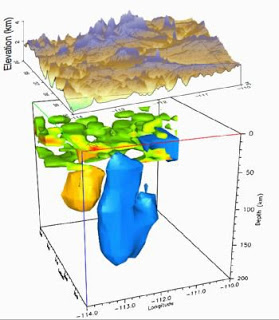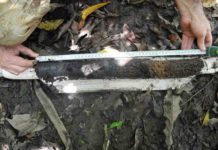
A paper published today in the journal Nature shows how magmatic material from the depths slowly rises to invade the lithosphere — Earth’s crust and strong uppermost mantle. This movement forces layers to peel away and sink, said lead author Alan Levander, professor and the Carey Croneis Chair in Geology at Rice University.
The invading asthenosphere is two-faced. Deep in the upper mantle, between about 60 and 185 miles down, it’s usually slightly less dense and much less viscous than the overlying mantle lithosphere of the tectonic plates; the plates there can move over its malleable surface.
Levander and his fellow researchers know this because they’ve seen evidence of the process from data gathered by the massive USArray seismic observatory, hundreds of observatory-quality seismographs deployed 45 miles apart in a mobile array that covers a north/south strip of the United States.
Levander said USArray has found similar downwellings in two other locations in the American West; this suggests the forces deforming the lower crust and uppermost mantle are widespread. In both other locations, the downwellings happened within the past 10 million years. “But under the Colorado Plateau, we have caught it in the act,” he said.
“We had to find a trigger to cause the lithosphere to become dense enough to fall off,” Levander said. The partially molten asthenosphere is “hot and somewhat buoyant, and if there’s a topographic gradient along the asthenosphere’s upper surface, as there is under the Colorado Plateau, the asthenosphere will flow with it and undergo a small amount ofdecompression melting as it rises.”
It melts enough, he said, to infiltrate the base of the lithosphere and solidify, “and it’s at such a depth that it freezes as a dense phase. The heat from the invading melts also reduces the viscosity of the mantle lithosphere, making it flow more readily. At some point, the base of the lithosphere exceeds the density of the asthenosphere underneath and starts to drip.”










